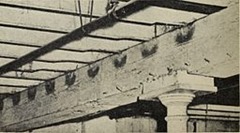
You trap mice and rats with glue traps only when they step inside the glue traps, so place the glue trap where they travel every night. And where is that?
- The grey marks on the side of the support beam in the picture are made by rodents so here it is easy to see where they travel.
- The right place for a glue trap is close to a wall. Mice and rats like to keep their “whiskers” in contact with a flat surface.
- The wrong place for a glue trap is in the middle of the floor. Rodents only travel through open spaces when it’s absolutely necessary, and there’s no trail to lead the pest to the trap.
- The right place for a glue trap is where mice or rats have left a trail of droppings or urine. They “go” on the go as a signal for other rodents to follow them.
- The wrong place for a glue trap is close to a hole in the wall or a door, or under a stove or refrigerator close to the open floor. If the first thing a rodent encounters when it ventures out is your trap, there’s a good chance it will just find another way in.
- The right place for a glue trap is any area where you have a cockroach infestation, too. Rats and mice eat cockroaches. Cockroaches also get stuck in glue traps. Rodents will get caught in the trap trying to catch the roach. They will also dine on scorpions, centipedes, millipedes, and grasshoppers, among many other insects.
- The wrong place for a glue trap is any open space with a temperature below 50 F (about 10 C) or above 85 F (about 30 C). If the room is too cold, the glue hardens. If the room is too warm, rodents avoid it.
- The right place for a glue trap is next to another glue trap. If the mouse or rat leaps over the first glue trap, it will get caught in the second.
- The wrong place for a glue trap is by itself. Glue traps, like snap traps, are best laid out in pairs about an inch (2.5 cm) apart.
- The right place for a glue trap is someplace poorly lit. You want rodents to use as few of their senses as possible when they approach a trap.
- The wrong place for a glue trap is under a light fixture. Rodents don’t see very well, but they can see in strong light. And, finally,
The wrong place for a glue trap is anywhere open to pets or children. A tunnel trap actually can capture a new-born kitten or puppy. The trap won’t kill them, but they might be attacked by rats, and the result can be gruesome. And you just don’t want small children playing with mice, rats, or traps.
If you want to be certain that you are placing the traps in the right place, you could catch the rodents on video using a camera trap. I’ve written a review of the top 3 camera traps here.

Leave a Reply